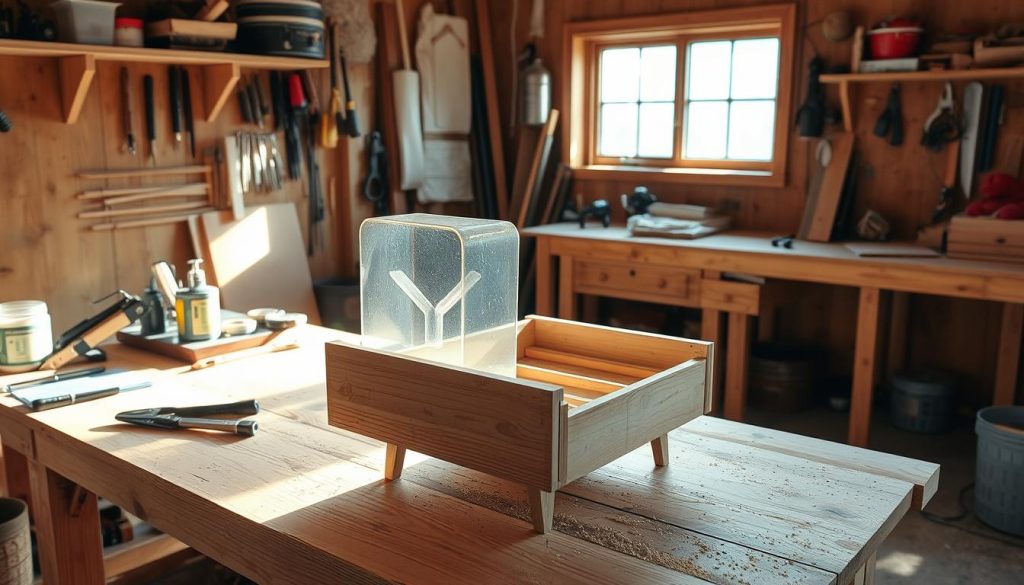
Raising backyard chickens is more fun when you make your own feeders. A homemade chicken feeder saves money and meets your flock’s needs. It’s a unique way to feed your chickens.
Chicken keepers know a good feeder is key. You can make a reliable feeder with simple tools and materials. It keeps your chickens healthy and happy.
Creating your own feeder lets you control its design and function. It’s fun and useful, whether you have a few chickens or a big farm. A homemade feeder project is rewarding.
Key Takeaways
- DIY chicken feeders are cost-effective
- Custom designs improve chicken nutrition
- Building your own feeder requires minimal skills
- Homemade feeders can be easily modified
- Personalized feeders reduce waste and protect feed
Understanding the Importance of Proper Chicken Feeders
Raising backyard chickens means paying close attention to their diet. The right feeders are key to keeping them healthy and productive. A good feeding system can greatly improve your chickens’ health and happiness.
Benefits of Custom-Built Feeders
Custom chicken feeders have many benefits for backyard chicken owners:
- Less feed waste
- Better cleanliness
- Protection from pests
- Designed for your flock’s needs
Common Feeding Challenges for Backyard Chickens
Chicken owners face several feeding challenges. Moisture, contamination, and poor feed distribution are big concerns. These issues can be solved with well-designed feeders.
Cost Savings of DIY Solutions
Making your own chicken feeders can save a lot of money. DIY feeders are cheaper than buying them and can be tailored to your chickens’ needs.
Understanding these points helps chicken owners create better feeding systems. Proper feeding is crucial for raising healthy backyard chickens.
Essential Materials and Tools for Your Project
Building a DIY chicken feeder needs careful planning and the right supplies. Backyard chicken lovers can make a great feeder with basic items from hardware stores and coop accessories.
Before you start, collect these key materials:
- PVC Pipe (4-6 inches in diameter)
- Plastic Bucket with lid
- Drill with various bit sizes
- Measuring tape
- Waterproof sealant
- Screws and washers
- Sandpaper
You’ll need a good toolkit for building chicken feeders easily. Using top-notch tools means your feeder will last and work well for your chickens.
When picking materials for coop accessories, think about:
- Durability against weather
- Ease of cleaning
- Protection from pests
- Matching your coop design
Choosing quality supplies saves you from future upkeep. With the right stuff and some creativity, you’ll create a feeder that keeps your chickens healthy and happy.
Types of DIY Chicken Feeder Designs
Creating the perfect chicken feeder means knowing about different designs. These designs cater to your flock’s needs. By exploring these options, you can make feeding time better for your chickens.
Choosing the right feeder involves thinking about your flock’s size and needs. Here are three DIY feeder designs that can change how you care for your chickens.
Gravity-Fed Systems: Simplicity in Action
Gravity-fed feeders are smart for keeping chickens fed all the time. They use gravity to keep feed flowing as chickens eat. The benefits are:
- Less work for you
- Feed is always distributed right
- Less waste and mess
- They’re easy to make with simple materials
PVC Pipe Feeders: Durable and Cost-Effective
PVC pipe feeders are loved for being tough and affordable. They’re also very versatile:
- They can handle the weather
- They’re easy to clean
- You can adjust their size
- They keep feed clean
Bucket-Style Options: Practical and Spacious
Bucket-style feeders hold a lot of feed and keep it safe. They’re great for bigger flocks, offering:
- They hold a lot of feed
- They protect feed from moisture and pests
- They’re easy to make
- They can be mounted in many ways
Each design has its own benefits for your backyard chickens. Think about what your flock needs to pick the best feeder.
Safety Considerations for Chicken Feeder Construction
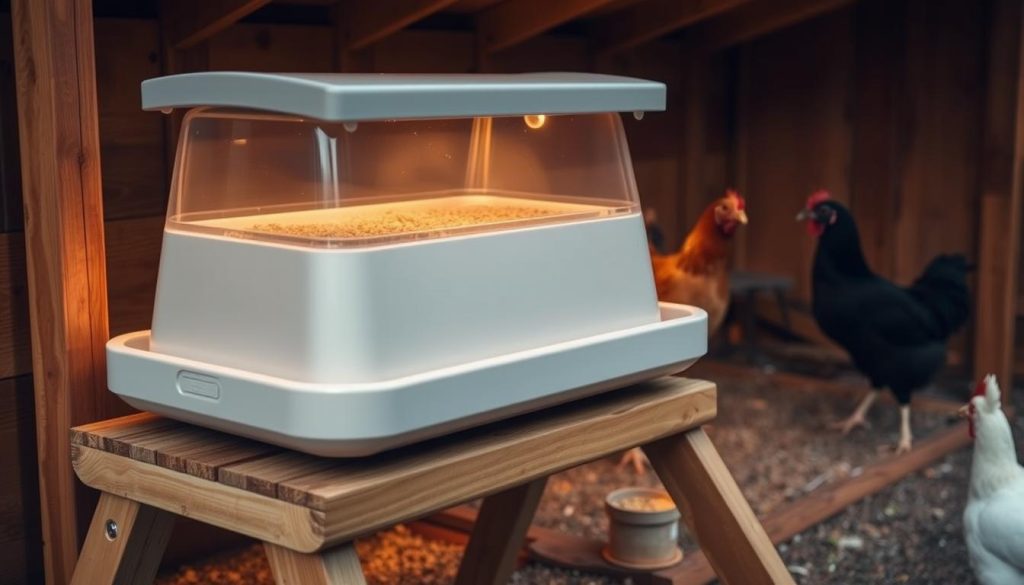
Keeping your backyard chickens safe is very important. A safe feeding area is key for their health. Using the right materials and design can help avoid dangers.
Choosing the right materials is crucial. Stay away from harmful chemicals or materials that break down fast. Good options include:
- Food-grade plastic
- Stainless steel
- BPA-free containers
- Untreated wood
Make sure your feeder is sturdy. It should have:
- Smooth edges to prevent injury
- Stable base to prevent tipping
- Proper ventilation
- Protection from moisture and contaminants
Good design can lower the chance of feed contamination and health problems for your chickens. Keep your feeder clean and in good shape with regular checks.
Think about adding features that cut down on waste and keep the area clean. Features like raised edges, adjustable height, and covered sections help. They protect the feed from rain, dirt, and pests, making sure your chickens can eat safely.
Step-by-Step Guide to Build a Basic DIY Chicken Feeder
Making a homemade chicken feeder is a fun and cost-effective project for those who keep backyard chickens. It doesn’t matter if you’re new to chicken keeping or have years of experience. This guide will show you how to make a simple yet effective diy chicken feeder that will keep your chickens well-fed.
First, get all the materials you need for your homemade chicken feeder. Having everything ready will make the building process easier and more enjoyable.
Preparation Materials
- 5-gallon plastic bucket with lid
- PVC pipe (2-inch diameter)
- Drill with various bit sizes
- Waterproof sealant
- Measuring tape
- Marker or pencil
Assembly Process
Building your diy chicken feeder needs attention to detail. Here’s how to make a feeder that will work well for your chickens:
- Clean the bucket well
- Mark where you want the feed ports
- Drill holes that are the right size
- Put in the PVC pipe feeding system
- Seal the drill points with waterproof sealant
Final Adjustments
After you’ve built your homemade chicken feeder, do these important checks:
| Check Point | Action |
|---|---|
| Hole Size | Make sure the holes are 1-1.5 inches in diameter for easy access |
| Sealant | Check that the sealant covers all drill points |
| Placement | Place it at chicken head height |
Pro tip: Test your diy chicken feeder with a small amount of feed first. This will make sure it works well before you use it all the time.
Creating an Automatic Feeding System
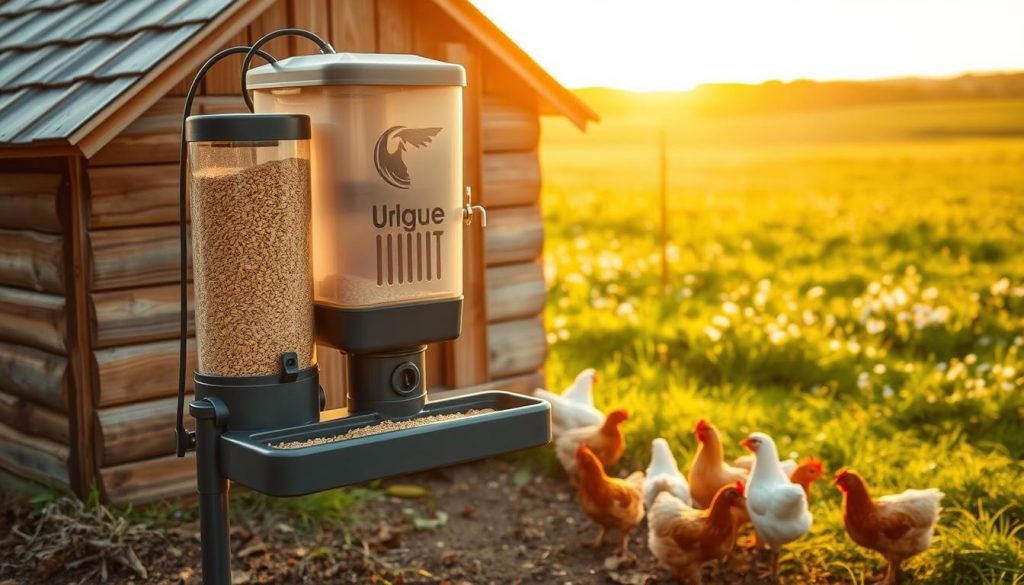
Automatic chicken feeders make caring for backyard chickens easier. They keep chickens fed without needing to do it by hand. This saves time and effort for chicken owners.
Building an automatic feeding system has many benefits:
- Chickens get food at the same time every day
- Less work for the owner
- Just the right amount of food is given
- It’s easier to manage the flock
There are many types of automatic feeders to choose from. Gravity-fed systems are the simplest. They let feed flow as chickens eat.
For more features, you can get feeders with timers and settings. These advanced feeders make sure chickens eat well, even when you’re not home.
When making an automatic feeder, remember a few things:
- Use materials that can stand up to the weather
- Figure out how much feed you need
- Make it safe from predators
- Make it easy to clean and fix
With some planning and design, you can make a feeder that makes chicken care easier. It will also make sure your chickens get the food they need.
Weather-Proofing Your Chicken Feeder
Keeping chicken feeders safe from bad weather is key to your chickens’ health. Weather-proofing keeps the feed dry and fresh all year. This is important for your chickens’ nutrition.
Good weather protection comes from smart design and placement. Chickens need clean, dry feed all the time. So, it’s vital to have weather-resistant feeders for their care.
Protection Against Rain
Rain can ruin chicken feed, causing mold and bacteria. Feeders should have features to keep feed dry:
- Sloped roofs to keep water away
- Overhanging covers with long edges
- Raised feeding stations
Preventing Moisture Damage
Keeping feed dry is crucial. Ventilated designs stop condensation. Here are ways to prevent moisture:
- Use waterproof materials like treated wood or plastic
- Install drainage holes in feeder bases
- Place feeders under natural shelter when you can
Seasonal Adaptations
Feeders need different designs for each season. In winter, they should be more closed. In summer, they need more air. Adaptable feeders help chickens get the best nutrition all year.
Using these weather-proofing tips will protect your investment. It also ensures your chickens always have quality feed, no matter the weather.
Maintenance Tips for Homemade Feeders
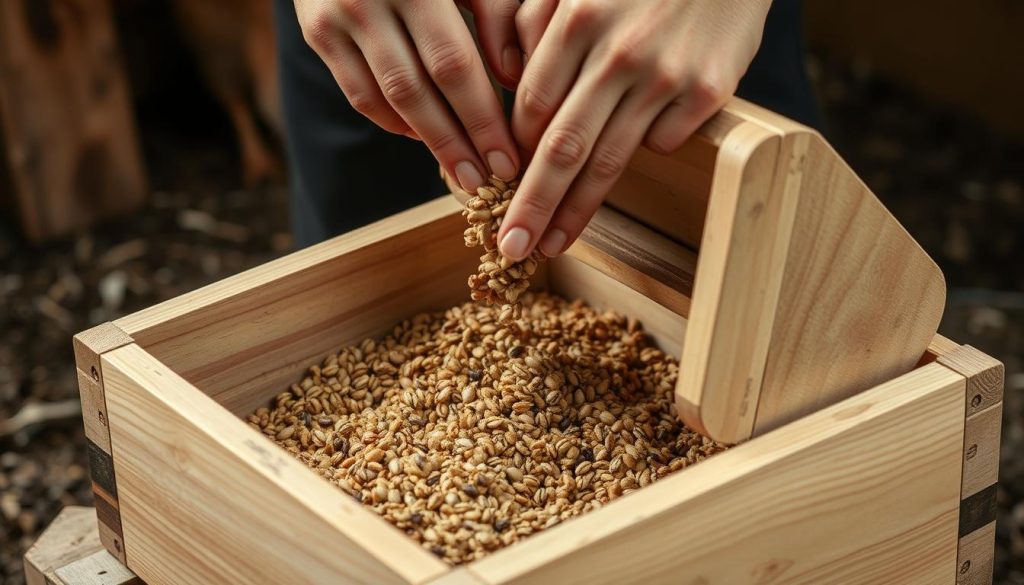
Raising backyard chickens means you need to take care of their food equipment. Keeping homemade chicken feeders clean and in good shape helps your chickens stay healthy. It also makes sure your DIY feeder lasts for a long time.
Cleaning your homemade chicken feeders regularly is key. Chickens can make a mess, and old food can attract pests and grow harmful bacteria.
- Clean feeders weekly with mild soap and water
- Make sure they’re dry before adding more food
- Check for cracks or damage while cleaning
- Replace any worn-out parts right away
Homemade chicken feeders can wear out over time. It’s smart to check them every month for any damage. Look for signs like:
- Rust on metal parts
- Plastic that’s breaking down
- Connections that are loose
- Food getting stuck
Pro tip: Keep a small repair kit handy with basic tools and parts for quick fixes. Taking care of your feeders ahead of time keeps your chickens’ meals on schedule. It also helps your DIY feeder last longer.
By following these easy maintenance tips, your homemade chicken feeders will stay a reliable and efficient part of your backyard chicken setup.
Preventing Feed Waste and Pest Problems
Chicken owners face big challenges with feed waste and pests. They need smart chicken feeders to keep their flock healthy. This means designing feeders well and managing them carefully.
Starting with good feed management is key. It’s about cutting down waste and keeping pests away. Designing feeders smartly can really help keep things clean and efficient.
Smart Design Features to Minimize Waste
- Install catch trays beneath feeding ports to collect scattered feed
- Use adjustable feeding ports that control grain access
- Choose chicken feeders with narrow openings to prevent excessive spillage
- Select feeders with raised edges to keep feed contained
Pest Control Solutions for Chicken Feeders
To keep pests out, you need a few strategies:
- Select rodent-proof feeder designs with secure closures
- Position feeders away from potential wildlife hiding spots
- Use metal or heavy-duty plastic materials resistant to pest damage
| Pest Prevention Method | Effectiveness | Implementation Difficulty |
|---|---|---|
| Elevated Feeder Platforms | High | Easy |
| Covered Feeding Areas | Medium-High | Moderate |
| Sealed Storage Containers | High | Easy |
Using these methods can help protect your feed and keep your flock healthy.
Advanced DIY Chicken Feeder Modifications
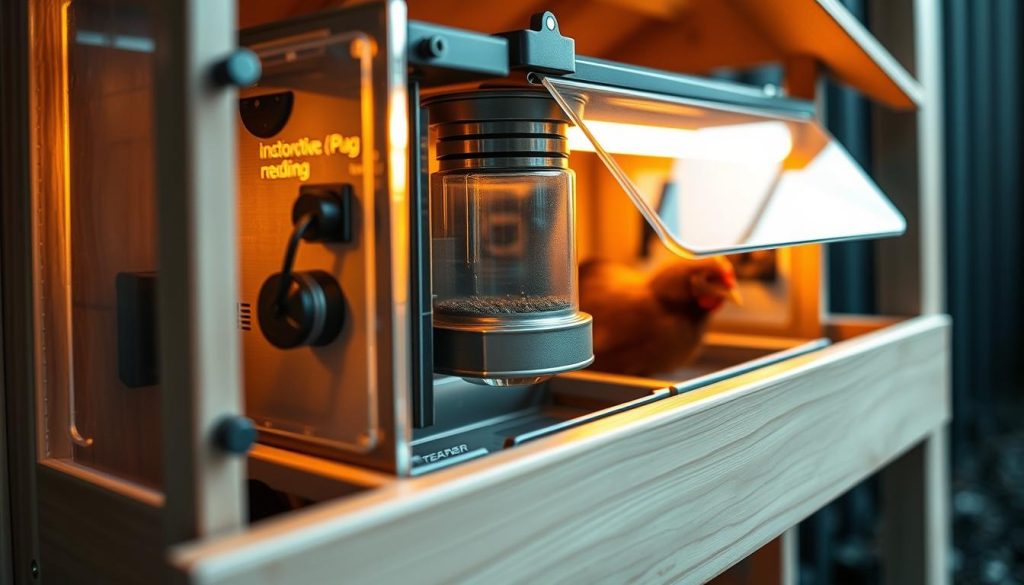
Experienced chicken keepers can turn a simple DIY chicken feeder into a more advanced system. By adding new features, you can make feeding easier and more efficient. This makes caring for your chickens more convenient.
Several advanced changes can make your DIY chicken feeder better:
- Self-Leveling Mechanism: Make a feeder that automatically spreads out the feed
- Integrated Grit Dispensers: Mix feed and minerals in one place
- Multi-Compartment Systems: Have different areas for different types of feed
- Weather-Resistant Designs: Add covers and features to keep out water
Professional chicken farmers suggest adding smart features like tilting platforms or pedal-activated dispensers. These ideas help cut down on waste and prevent contamination.
When making advanced DIY chicken feeder changes, think about durability, easy cleaning, and fitting different flock sizes. Using stainless steel and modular designs can improve your feeder’s performance.
By spending time on creative changes, backyard chicken keepers can create custom feeding solutions. These solutions meet their unique needs.
Sizing Your Feeder for Your Flock
Creating the perfect chicken feeder for your backyard chickens is all about planning and measuring. The size of your feeder affects your chickens’ health and how well they do. The right size ensures everyone gets food and cuts down on waste.
Several important factors help figure out the best feeder size. You need to think about how many chickens you have, their breed, and how much food they need every day. These details are key for making good chicken feeder plans.
Capacity Calculations
To find the right feeder size, you need to know a few things:
- Adult chickens eat about 1/4 to 1/2 pound of food each day
- Count how many chickens you have and multiply by their daily food needs
- Add 10-15% more space for flexibility
Space Requirements
It’s important to have enough space for all chickens to eat without fighting:
- Give each chicken 2-3 inches of feeder space
- Choose wider feeders to avoid overcrowding
- Put feeders at chicken shoulder height for easy access
Pro tip: Always watch how your chickens eat and change your feeder plans if needed to keep them healthy and well-fed.
Incorporating Your Feeder into the Coop Design
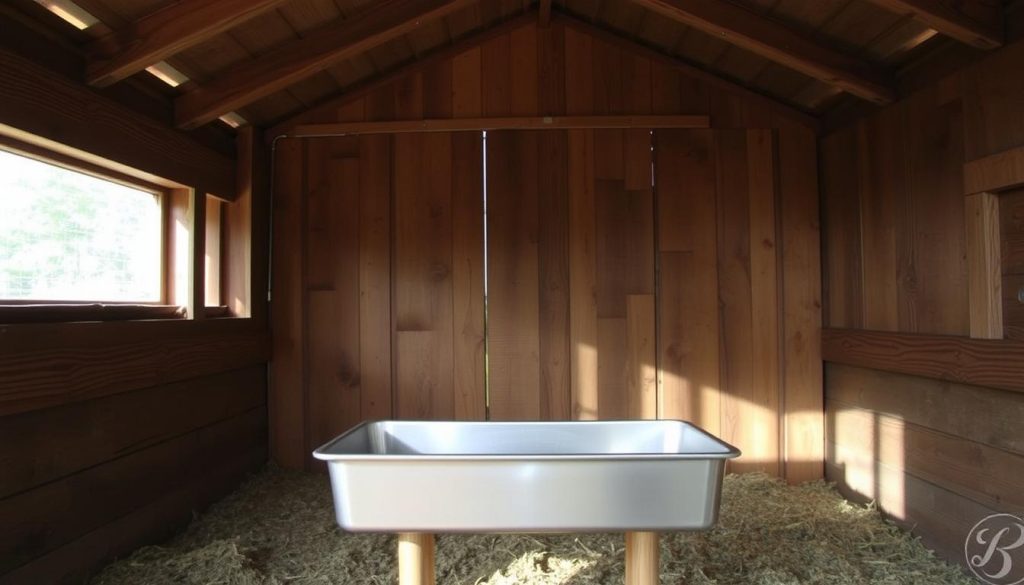
Creating the perfect feeding area is key for backyard chickens. Your accessories should fit well with the coop’s design. This makes feeding time better for your chickens.
Putting feeders in the right spot can make your coop stand out. Here are some tips for integrating feeders:
- Wall-mounted feeders to save floor space
- External feeding stations with weather protection
- Built-in compartments that blend with coop design
- Easily accessible refill points
Choosing the right spot for feeders is important. You want a space that keeps feed clean and dry. It should be easy for chickens and humans to get to.
| Feeder Location | Pros | Cons |
|---|---|---|
| Interior Wall | Protected from elements | Limited space |
| External Station | Easy maintenance | Potential weather exposure |
| Covered Area | Balanced protection | Requires additional construction |
Pro tip: Always ensure your feeder is positioned to minimize feed contamination and maximize chicken comfort during feeding times.
Adding creative accessories to your chicken coop can make it both useful and nice to look at. Spend time thinking about where to put your feeder.
Troubleshooting Common DIY Feeder Issues
Making homemade chicken feeders needs ongoing care and sometimes fixing problems. Backyard chicken keepers often face issues with their DIY feeders. These problems can affect their chickens’ food and how they eat.
Spotting and fixing problems early can stop bigger issues with your chicken feeders. Knowing common problems helps keep your feeder working well.
Quick Fixes for Persistent Problems
When dealing with homemade chicken feeders, a few quick fixes can solve common issues:
- Clean feed ports often to stop clogs
- Look for rust or corrosion in metal parts
- Check seals and connections for leaks
- Adjust the feeder’s height to avoid spills
When to Rebuild Your Chicken Feeder
Some damage needs more than quick fixes. You might need to rebuild your chicken feeder when:
- The structure is badly damaged
- Rust has harmed metal parts a lot
- Fixing it costs more than buying a new one
- The feeder doesn’t meet your chickens’ nutritional needs anymore
Regular maintenance keeps your DIY chicken feeders working well. Checking them often and fixing problems quickly can make your homemade feeder last longer.
Conclusion
Building a custom diy chicken feeder is more than a weekend project. It’s an investment in your backyard chickens’ health and happiness. You’ve learned to create practical, efficient feeding solutions that save money and improve nutrition.
Your homemade feeder shows you care about chicken keeping. You’ve learned about design, safety, and maintenance. Each DIY chicken feeder you make shows your commitment to caring for animals in a sustainable way.
Backyard chickens do well when their caretakers are proactive and creative. You now know how to adapt feeding systems and solve problems. This knowledge turns a simple task into a fun and rewarding experience.
Every feeder is a chance to learn. Start simple, watch your chickens, and keep improving your design. With time, you’ll get better at making chicken keeping fun and efficient.
FAQ
How much does it cost to build a DIY chicken feeder?
Building a DIY chicken feeder can cost between $10 and $50. You can make a basic feeder from recycled materials like PVC pipes, buckets, or scrap wood. This can save money compared to buying one.
What materials are best for making a chicken feeder?
Good materials for chicken feeders include food-grade plastic, PVC pipes, galvanized metal, and weatherproof wood. Stay away from materials that rust, have harmful chemicals, or get damaged by moisture. Choose food-safe plastics and metals that don’t rust for the best results.
How often should I clean my homemade chicken feeder?
Clean your chicken feeder once a week to stop mold, bacteria, and pests. Automatic or enclosed feeders need a deep clean every 2-3 weeks. Keeping it clean ensures your chickens eat fresh, healthy food and stay healthy.
Can I make an automatic chicken feeder at home?
Yes, you can make an automatic chicken feeder at home. You can use gravity-fed systems, timers, or solar power. You’ll need materials like 5-gallon buckets, PVC pipes, and basic electronics for more complex designs.
How do I prevent feed waste in my DIY chicken feeder?
To cut down on feed waste, use feeders with raised edges, narrow ports, and catch trays. Gravity-fed or hanging designs help prevent chickens from kicking out feed. Adjust the openings and use sloped bottoms to control feed and reduce spills.
What size feeder do I need for my backyard flock?
The feeder size depends on your flock’s size. Aim for 2-3 inches of space per chicken. For 4-6 chickens, a 5-10 pound feeder is good. Larger flocks might need bigger feeders or more than one.
How can I weatherproof my outdoor chicken feeder?
To weatherproof your feeder, use water-resistant materials and add covers. Place it in a sheltered spot. Use galvanized metal or sealed wood, and cover it like a roof. Position it under coop overhangs or in protected areas to keep it dry and safe.
Are DIY chicken feeders safe for my chickens?
DIY feeders can be very safe if made right. Make sure they have smooth edges and use food-safe materials. They should be stable and checked often for damage. Avoid sharp corners and unstable designs to keep your chickens safe.
